| |
|
Xiamen Oil Paintings, Wholesale Direct!
|
|
100% hand painted, 100% cotton canvas, 100% money back if not satisfaction. |
|
|
|
|
ART WORKS INDEX
A
B
C
D
E
F
G
H
I
J
K
L
M
N
O
P
Q
R
S
T
U
V
W
X
Y
Z
|
|
ARTISTS INDEX
A
B
C
D
E
F
G
H
I
J
K
L
M
N
O
P
Q
R
S
T
U
V
W
X
Y
Z
|
|
|
|
|
|
|
|
 |
Kristian Zahrtmann
|
|
(31 March 1843 - 22 June 1917) was a Danish painter. He was a part of the Danish artistic generation in the late 19th century, along with Peder Severin Krøyer and Theodor Esbern Philipsen, who broke away from both the strictures of traditional Academicism and the heritage of the Golden Age of Danish Painting, in favor of naturalism and realism.
He was known especially for his history paintings, and especially those depicting strong, tragic, legendary women in Danish history. He also produced works of many other genres including landscapes, street scenes, folk scenes and portraits.
He had a far-reaching effect on the development of Danish art through his effective support of individual style among his students during the many years he taught, and by his pioneering use of color.
|
|
 |
kristian
|
|
kristian foddes den 12 april 1577 och blev kung av danmark som elvaaring 1588.
|
|
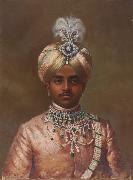 |
Krishna Raja Wadiyar IV
|
|
Krishna Raja Wadiyar IV (June 4, 1884 - August 3, 1940, Bangalore Palace), also known popularly as Nalwadi Krishna Raja Wadiyar was the ruling Maharaja of the princely state of Mysore from 1902 until his death in 1940. He is regarded as one of the most celebrated rulers among the Indian States when India was still under British rule. At the time of his death, he was also one of the world's wealthiest men, with a personal fortune estimated in 1940 to be worth $400 million which would be equivalent to $56 billion in 2010 prices.
|
|
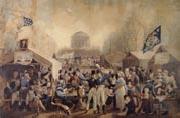 |
Krimmel John
|
|
American portrait and genre painter.
b.1789 d.1821
|
|
|
|
|
|
|
|
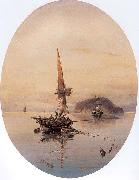 |
Konstantinos Volanakis
|
|
(Greek, b. Heraklion, Crete, 1837- d. 29 June 1907) was a Greek painter, considered one of the best of the 19th century. Born to a wealthy family, he went to Trieste, Italy, in 1856 where he took up painting. He studied in the Munich Academy. He is one of the foremost representatives of the Munich School, a Greek artistic movement of the 19th century. Michalis Oikonomou, another Greek painter, was one of his pupils.
He died in 1907. His works are today exhibited in major museums in Greece and abroad.
|
|
 |
Konstantin Somov
|
|
Russian Symbolist Painter, 1869-1939
Russian painter and graphic artist. He was the son of a curator at the Hermitage, and he attended the St Petersburg Academy of Art from 1888 to 1897, studying under the Realist painter Il'ya Repin from 1894. In 1897 and again in 1898-9 he went to Paris and attended the studios of Filippo Colarossi and of Whistler. Neither the Realism of his Russian teachers nor the evanescent quality of Whistler's art was reflected for long in Somov's work. He turned instead for inspiration to the Old Masters in the Hermitage and to works of contemporary English and German artists
|
|
 |
Konstantin Savitsky
|
|
Russian Painter, 1844-1905
was a Russian realist painter born in the city of Taganrog in the village Frankovka or Baronovka, named after former governor Otto Pfeilizer-Frank. Today this area is occupied by Taganrog Iron and Steel Factory TAGMET. Savitsky's family lived in the building of Taganrog Gymnasium for Boys, where his father worked as a doctor. In Frankovka the family rented a summer house. Savitsky spent his childhood and youth in Taganrog. He showed an interest for painting in the early childhood. Being on the shore of Azov Sea with his parents, he loved to make sketches, and drawing lessons at Gymnasium were his favourite subject. When Konstantin was fifth-grader at Taganrog Gymnasium, his teenager's life changed unexpectedly. Both of his parents died suddenly. Kostya was taken by his uncle who lived in present-day Latvia and became his guardian. There Savitsky entered a private boarding-school and in 1862 he graduated and left for Saint Petersburg, where entered The Imperial Academy of Arts in Saint Petersburg. Personal contacts with outstanding representatives of Russian culture - Ilya Repin, Ivan Shishkin, Viktor Vasnetsov, Mark Antokolski, Stasov, Nikolai Mikhailovich Karamzin - made a great influence on development of the young artist. Soon Savitsky became one of the best students of the Imperial Academy of Arts. His student paintings were awarded with silver medals and for his painting "Cain and Abel"1871 he received a gold medal. House of Savitsky in Taganrog. TaganrogCity.ComAfter graduation from Imperial Academy of Arts and two years abroad, the artist becomes co-partner of mobile art exhibitions (Peredvizhniki, a group of Russian realist artists who in protest to academic restrictions formed an artists' cooperative, which evolved into the Society for Traveling Art Exhibitions in 1870. The artwork "Repairing Railway" was one of the first paintings of that time dedicated to life of the working class. Konstantin Savitsky is a co-author of the famous painting Morning in the Pine Forest. On the original Peredvizhniki exhibition the painting was shown by two authors Ivan Shishkin and Konstantin Savitsky. It was assumed that Savitsky had painted the bears and Shishkin the forest but later the scholars found that preparational drawing of the pine forest were made by both Savitsky and Shishkin. Later Savitsky withdrew his signature from the painting and it is currently exponated as a sole Shishkin's work. The titles of his artworks as "Lost all their possessions in the fire", "To war", "Herdsmen", "Krutchnik",
|
|
 |
Konstantin Makovsky
|
|
1839 September 17 [O.S. September 30] 1915) was an influential Russian painter, affiliated with the "Peredvizhniki (Wanderers)". Many of his historical paintings, such as The Russian Bride's Attire (1889), showed an idealized view of Russian life of prior centuries. He is often considered a representative of a Salon art.
Konstantin was born in Moscow as the older son of a Russian art figure and amateur painter, Yegor Ivanovich Makovsky. Yegor Makovsky was the founder of Natural class, the art school that later became as the famous Moscow School of Painting, Sculpture and Architecture. Among the friends of the family were Karl Briullov and Vasily Tropinin. All children of Yegor became notable painters (see Makovsky). Later Konstantin wrote For what I became I think I should thank not the Academy or Professors but only my father.
In 1851 Konstantin entered the Moscow School of Painting, Sculpture and Architecture where he became the top student, easily getting all the available awards.
|
|
 |
Konstantin Korovin
|
|
1861-1932
Russian Konstantin Korovin Galleries
Konstantin was born in Moscow to a merchant family officially registered as peasants of Vladimir gubernia. His father, Aleksey Mikhailovich Korovin, earned a University degree and was more interested in arts and music than in the family business established by Konstantin's grandfather. Konstantin's older brother Sergey Korovin was a notable realist painter. Konstantin's relative Illarion Pryanishnikov was also a prominent painter of the time and a teacher at the Moscow School of Painting, Sculpture and Architecture.
In 1875 Konstantin entered the Moscow School of Painting, Sculpturing and Architecture, where he learned from Vasily Perov and Alexei Savrasov. His brother, Sergey was already a student of the School. During their scholar years Korovins became friends with their fellow students Valentin Serov and Isaac Levitan, Kontantin kept these friendship through the whole of his life.
In 1881-1882, Korovin spent a year at the Imperial Academy of Arts in Saint Petersburg, but returned disappointed to the Moscow School of painting, sculpturing and architecture. He studied at the school under the new teacher Vasily Polenov until 1886.
In 1885, Korovin made traveled to Paris and Spain. Paris was a shock for me?? Impressionists?? in them I found everything for what I was scolded back at home, in Moscow, he later wrote.
Korovin. On the balcony, Spanish women Leonora and Ampara. 1897-1898.Polenov introduced Korovin to Savva Mamontov's Abramtsevo circle: Viktor Vasnetsov, Apollinary Vasnetsov, Ilya Repin, Mark Antokolsky and others. The Abramtsevo circle's love for stilized Russian themes is reflected in Korovin's picture A Northern Idyll. In 1885 Korovin works for Mamontov's Opera house. He designed the stage decor for Giuseppe Verdi's Aida, L??o Delibes' Lakme and Georges Bizet's Carmen.
St. Triphon's Brook in Pechenga. 1894.In 1888, Korovin traveled with Mamontov to Italy and Spain, where he produced painting On the balcony, Spanish women Leonora and Ampara. Konstantin traveled within Russia, Caucasus and Central Asia, exhibited with Peredvizhniki. He was painting in the Impressionist and later in the Art Nouveau style.
In the 1890s, Korovin became a member of the Mir iskusstva art group.
Korovin's subsequent works was strongly influenced by his travel to the North. In 1888 he was captivated by the stern northern landscapes, as seen in The Coast of Norway and The Northern Sea.
His second trip to the North, with Valentin Serov in 1894, coincided with the construction of the Northern Railway. Korovin painted a large number of landscapes: Norwegian Port, Saint Trifon's Brook in Pechenega, Hammerfest: Aurora Borealis, The Coast at Murmansk and others. The paintings are built on a delicate web of shades of grey. The etude style of these works was typical for the Korovin's art of the 1890s.
Using material from his northern trip, Korovin designed the Northern Railway pavilion at the All Russia Exhibition of 1896 at Nizhny Novgorod.
In 1900, Korovin designed the Central Asia section of the Russian Empire pavilion on the Paris World Fair; and was awarded the Legion of Honour by the French government.
Spring, 1917In the beginning of the 20th century Korovin focused his attention on the theatre. He moved from Mamontov's opera to Mariinsky Theatre in Saint Petersburg. Departing from the tradition of the stage decor, which only indicated the place of action, Korovin produced a mood decor, which conveyed the general emotions of the performance. Korovin designed sets for Constantin Stanislavski's dramatic productions, as well as Mariinsky's operas and ballets. He did the stage design for such Mariinsky's productions as Faust (1899), The Little Humpbacked Horse (1901) and Sadko (1906) that became famous for their expressiveness.
Pier in Gurzuf, 1914In 1905, Korovin became an Academician of Painting, and in 1909-1913 he was a professor at the Moscow School of Painting, Sculpture and Architecture.
One of the artist's favourite themes was Paris. He painted A Paris Cafe (1890s'), Cafe de la Paix (1905'), La Place de la Bastille (1906), Paris at Night; Le Boulevard Italien (1908'), Night Carnival (1901), Paris in the Evening (1907) and others.
During the World War I Korovin worked as a camouflage consultant at the headquarters of one of the Russian armies and was often seen at the front line. After the October Revolution Korovin continued to work in the theatre, designing stage for Richard Wagner's Die Walk??re and Siegfried as well as Pyotr Ilyich Tchaikovsky's The Nutcracker (1918-1920).
In 1923 Korovin moved to Paris by the advice of the Commissar of Enlightenment, Anatoliy Vasilievich Lunacharsky, to cure his heart condition and help Korovin's handicapped son. There was supposed to be a large exhibition of Korovin's works but the works were stolen and Korovin was left penniless. For years he produced the numerous Russian winters and Paris boulevards just to make ends meet.
In the last years of his life he produced stage designs for many of the major theatres of Europe, America, Asia and Australia, the most famous of which is his scenery for a production by the Turin Opera House of Nikolai Rimsky-Korsakov's The Golden Cockerel.
Korovin died in Paris on September 11, 1939.
Konstantin's son Alexey Korovin (1897-1950) was a notable Russian-French painter. Because of an accident during his childhood he had both feet amputated. Alexey committed suicide in 1950.
|
|
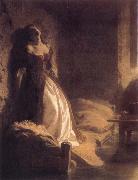 |
Konstantin Flavitsky
|
|
b Moscow, 25 Sept 1830; d St Petersburg, 15 Sept 1866,Russian painter. He completed his studies at the Academy of Arts in St Petersburg in 1855. The influence of Karl Bryullov was central to Flavitsky work. He combined the theatricality of academicism and the elegance of salon painting with a desire to observe a degree of realism in his subjects and to relate history to present events, thereby anticipating new developments in Russian history painting.
|
|
|
|
|
|
|
|
|
|
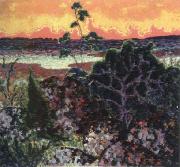 |
konrad magi
|
|
konrad magi(1878 to 1925),was an Estonian landscape painter. He was one of the most colour-sensitive Estonian painters of the first decades of the 20th century, and Magi works on motives of the island of Saaremaa are the first modern Estonian nature paintings.
Magi received his elementary art education from the drawing courses of the German Artisans Society of Tartu (1899?C1902.) At the same time, he was keenly engaged in theater, violin, and various sports.
Magi continued his art education as an unattached student in Saint Petersburg (1903?C1905.) In the autumn of 1907, he went to Paris. There Magi studied at a free academy. From 1908 to 1910, he lived in Norway. In 1912, Magi returned to Tartu, where he worked as an art teacher.
In Åland, he created delicate plant vignettes in the style of Art Nouveau: Kahekesi (Two together; 1908; China ink drawing). In Paris, Magi was influenced by Impressionism and Fauvism, which had a significant impact on his colours: Lilleline vali majakesega (A flower field with a little house; 1908?C1909), Norra maastik manniga (A Norwegian landscape with a pine; 1910).
From 1918, the influence of Expressionism is manifest, fostered by Mägi extreme sensitivity and emotional response to the anxious times: Puhajarv (Lake Puha); 1918?C1920), Otepaa maastik (Landscape of Otepaa; 1918?C1920). Also influenced by Expressionism are his big figure compositions Piet?? (1919), Kolgata (Golgatha; 1921).
Konrad Magi - Rannamaastik (Beach landscape)Magi new artistic period, begun on a trip to Italy, brought calmer tempers: Varemed Capril (Ruins in Capri; 1922?C1923). Along with nature pictures, he painted flowers and portraits. Magi mostly beautiful female models express the Art Nouveau ideal of beauty: Holsti (1916). In his later portraits from the 1920s, a more serious temper is expressed: Madonna (1923?C1924).
|
|
 |
Konrad Krzyzanowski
|
|
(1872-1922) was a Polish painter of powerful expressionist landscapes and vivid portraits, born in Kremenchuk in Ukraine. His art studies began in Kiev and were continued in St. Petersburg and Munich. In Warsaw he was a professor at the School of Fine Arts. He took his students for summer open - air sessions around Poland and to Lithuania and Finland. His seascapes were painted mostly in Finland. His works are mentioned briefly in a review of a show of "Independents" at the Royal Albert Hall, published in The New Age.Krzyżanowski died in Warsaw.
|
|
|
|
|
|
 |
KONINCK, Salomon
|
|
Dutch Baroque Era Painter, 1609-1656
He began his training in 1621 with David Colijns (c. 1582-after 1668), who gave him drawing lessons. He was then apprenticed to Fran?ois Venant (brother-in-law of Pieter Lastman) and completed his training with Claes Cornelisz. Moeyaert. By 1632 Salomon was a member of the Amsterdam Guild of St Luke. His wife Abigail was the daughter of the painter Adriaen van Nieulandt.
|
|
 |
KONINCK, Philips
|
|
Dutch Baroque Era Painter, 1619-1688
was a Dutch landscape painter.Little is known of his history except that he was said to be a pupil of Rembrandt, whose influence is to be seen in much of his work. He painted chiefly broad, sunny landscapes, full of space, light and atmosphere; they are seen from a high perspective, allowing a prominent view of the sky. Portraits by him, somewhat in the manner of Rembrandt, also exist (e.g. see Joost van den Vondel); there are examples of these in the galleries at Copenhagen and Oslo. Of his landscapes, the principal are View at the mouth of a river at the Hague, with a slightly larger replica in the National Gallery, London; Woodland border and countryside (with figures by Adriaen van de Velde) at Amsterdam; and landscapes in Brussels, Florence (the Uffizi), Berlin and Cologne. Koninck, a prosperous businessman, appears to have painted few pictures during the last decade of his life. Several of his works have been falsely attributed to Rembrandt and many more to his namesake and fellow townsman Salomon de Koninck (1609-1656), also a disciple of Rembrandt, whose paintings and etchings consist mainly of portraits and biblical scenes. Both of these painters are to be distinguished from David Koninck (1636-1687),
|
|
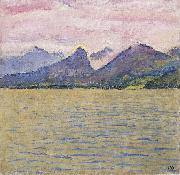 |
Koloman Moser
|
|
Koloman Moser (German pronunciation: [ˈkoːloman ˈmoːzɐ]) (March 30, 1868 - October 18, 1918) was an Austrian artist who exerted considerable influence on twentieth-century graphic art and one of the foremost artists of the Vienna Secession movement and a co-founder of Wiener Werkstätte.
During his life, Moser designed a wide array of art works - books and graphic works from postage stamps to magazine vignettes; fashion; stained glass windows, porcelains and ceramics, blown glass, tableware, silver, jewelry, and furniture - to name a few of his interests.
Born in Vienna, he studied at the Wiener Akademie and the Kunstgewerbeschule, where he also taught from 1899.
His designs in architecture, furniture, jewelry, graphics, and tapestries helped characterize the work of this era. Moser drew upon the clean lines and repetitive motifs of classical Greek and Roman art and architecture in reaction to the Baroque decadence of his turn-of-the-century Viennese surroundings.
In 1901/1902, he published a portfolio titled Die Quelle ("The Source") of elegant graphic designs for such things as tapestries, fabrics, and wallpaper.
In 1903, Moser and his colleague Josef Hoffmann founded Wiener Werkstätte, whose studios and artisans produced a number of aesthetically and functionally designed household goods, including glassware, flatware, silverware, and textiles. In 1904, he created the Apse mosaic and glass windows for the Kirche am Steinhof in Vienna.
Steinhof Church commemorative coin
In 1905, together with the Klimt group, he separated from the Vienna Secession. The same year, he married Editha (Ditha) Mautner von Markhof, the daughter to one of Austria's great industry fortunes.
In 1907 Kolo Moser, due to internal conflicts and as his plans for reorganising the Werkstätte (to cope with financial problems) weren't realised, withdrew from the Wiener Werkstätte.
Koloman was one of the designers for Austria's leading art journal Ver Sacrum. This art journal paid great attention to design and was designed mainly by Moser, Gustav Klimt and Josef Hoffmann.
|
|
 |
Koller, Rudolf
|
|
Swiss Painter, 1828-1905
Swiss painter. He studied in Zurich under such artists as Johann Jakob Ulrich before going to D?sseldorf in 1846 to work with Carl Ferdinand Sohn. In 1847 he was in Paris where he shared a studio with Arnold B?cklin. Two years later he went to Munich where he worked with a group of artists called the 'Schweizer', whose leader was Johann Gottfried Steffan. He returned to Zurich in 1851 and painted mainly pastoral landscapes (e.g. Waterfall near Zurich, c. 1851; Zurich, Graph. Samml. Eidgen?ss. Tech. Hochsch.) evoking prevailing romantic sensibilities. His later paintings combine realist subject-matter with a carefully arranged and executed classical composition. He frequently chose rustic farm scenes containing animals, whom he believed represented a dignified and pure image of nature that was to be treated with respect. He was often considered to be the 19th-century counterpart to Paulus Potter whose paintings of animals were emulated at the time. His works are similar to those of Rosa Bonheur, as seen in Cows in the Roman Countryside (1869; Berne, Kstmus.). His most celebrated painting is the St Gotthard Mailcoach (1873; Zurich, Ksthaus), which depicts a coach at full speed attempting to stop suddenly for a herd of cattle obstructing the narrow road. After 1870, problems with his eyesight forced him to paint less, yet even late in life he was still capable of producing such lyrical paintings as Horses at the Drinking Fountain (1890; Le Locle, Mus. B.-A.).
|
|
 |
Kole Idromeno
|
|
Kolë Idromeno (1860-1939) was an Albanian painter, sculptor, photographer, architect and engineer.
He was born in Shkodër, where he learned the first elements of photography from Pietro Marubi. In 1876 he stayed for some months at the Academy of Fine Arts in Venice (Accademia di Belle Arti di Venezia), and then worked in the studio of an Italian painter. When back in Albania (1878), he engaged himself in a number of different activities, working as an architect, sculptor, photographer, scene-painter, engineer and painter. He was the initiator of the first art exhibition in Shkodër (1923) and was represented in the first national art exhibition in Tirana (1931).
He established a very active photographic studio. Idromeno was the first painter to show motion pictures in Albania in 1912. He had kept up a correspondence with the Lumiere brothers in Paris.
|
|
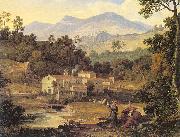 |
Koch, Joseph Anton
|
|
Austrian Painter, 1768-1839
Painter and writer. He was one of the most important landscape painters of the early 19th century. With his friend Johann Christian Reinhart he pioneered the 'heroic' landscape style by heightening the grandeur and structural clarity of classical Italianate landscapes in the tradition of Nicolas Poussin, Claude Lorrain and Gaspard Dughet. His work reflects a transitional period in European art. Largely under the influence of Asmus Carstens, Koch subscribed to many Neo-classical principles, but his work also has Romantic aspects. His interest in the natural sciences and Romantic philosophy betrayed an increasingly modern world-view, but he also embraced the medievalism of the Nazarenes.
|
|
 |
Knut Ekwall
|
|
was a Swedish painter, 3 April 1843 in Säby (Småland province), Sweden - 4 April 1912 in Säby.
Ekwall studied from 1860-1866 at the Academy of Arts in Stockholm, with emphasis on xylography (designing woodcut printing blocks) and drawing.
He became a pupil of the painter Ludwig Knaus in Berlin.
In 1870, Ekwall established himself as an artist in Munich in Germany and later worked in Leipzig.
His works during this period were primarily for magazine illustrations, and were reproduced as engravings.
He returned to Sweden and died there at the age of 69.
|
|
|
|
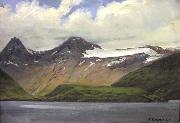 |
Knud Bergslien
|
|
(May 15, 1827 - November 27, 1908) was a Norwegian painter, art teacher and master artist. In his art, he frequently portrayed the lives of the Norwegian people, their history and heroes of the past. Bergslien is most associated with his historical paintings, especially Skiing Birchlegs Crossing the Mountain with the Royal Child.
Knud Larsen Bergslien was born in Voss, in Hordaland, Norway. His parents were Lars Bergeson Bergslien and Kirsten Knutsdotter Gjelle. Knud Bergslien was the brother of sculptor Brynjulf Bergslien and uncle of painter and sculptor Nils Bergslien. Monuments honoring the three famous Bergslien artists now exist in Bergslien park located in Voss, Hordaland
|
|
 |
KNELLER, Sir Godfrey
|
|
German-born English Baroque Era Painter, 1646-1723
English painter and draughtsman of German birth. He was the leading portrait painter in England during the late 17th century and the early 18th, and, as such, the chief recorder of court society for almost 40 years. He popularized the kit-cat format for portraits and was also the founding governor in 1711 of the first proper academy of art in England. His older brother Johann [John] Zachary Kneller (b L?beck, 1642; d London, 1702), with whom he was close, was also a painter; his works include watercolour miniatures and still-lifes,
|
|
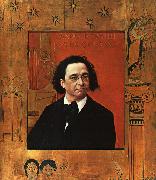 |
Klimt, Gustav
|
|
Austrian Art Nouveau Painter, 1862-1918
Artist Gustav Klimt, like composer Gustav Mahler, philosopher Ludwig Wittgenstein and big-time thinker Sigmund Freud, was a hotshot of Vienna's glory days as it ushered in the 20th century. Influenced by Impressionism, Symbolism and Art Nouveau, Klimt founded the Vienna Secession (1898), an avant-garde art movement that included a broad base of artisans and craftsmen as well as painters. Klimt himself was known more for elaborate graphic schemes than "painterly" work -- his most famous piece, The Kiss (1908), shows his distinctive gold-encrusted decorations over a semi-realistic portrait of an embracing couple. He used the framework of myth and allegory and he painted women, in ornate portraits and erotic exposures that were scandalous by Victorian-era standards. He also had time for more than painting -- after his death he was credited with as many as 14 illegitimate children. A big influence on the decorative arts in Austria, his most famous paintings include Salome
|
|
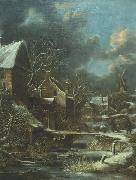 |
Klaes Molenaer
|
|
(1630, Haarlem - 1676, Haarlem), was a Dutch Golden Age painter.
According to the RKD he was the brother of the painters Bartholomeus and Jan Miense Molenaer. He became a member of the Haarlem Guild of St. Luke in 1651 and paid dues yearly until 1676.He was a landscape painter influenced by Jacob van Ruisdael.
|
|
 |
Kitty Kielland
|
|
Norwegian Painter, 1843-1914
was a Norwegian landscape painter. Kielland was born to an affluent family in Stavanger, the older sister of Alexander Kielland. Kielland's mutual interactions with her brother would be important to shaping her as an artist. Although she received some training in drawing and painting, it was not until she turned thirty that she was allowed to train as a professional artist. In 1873 she traveled to Karlsruhe where she was trained by Hans Gude. As a woman Kielland was forced to take private lessons from Gude instead of joining his landscape painting class. Gude's adherence to realism left a lasting impression on Kielland that was visible in her later works.[
|
|
 |
Kitagawa Utamaro
|
|
Japanese
1753-1806
Kitagawa Utamaro Gallery
Biographical details for Utamaro are extremely limited, and each reference gives a substantially different account.
Various accounts claim that he was born in either Edo (present-day Tokyo), Kyoto, or Osaka (the three main cities of Japan), or a provincial town (no one is sure exactly which one) in around 1753; the exact date is also uncertain. Another long-standing tradition has is that he was born in Yoshiwara, the courtesan district of Edo, the son of a tea-house owner, but there is no evidence of this. His original name was Kitagawa Ichitaro.
It is generally agreed that he became a pupil of the painter Toriyama Sekien while he was still a child, and there are many authorities who believe that Utamaro was his son as well. He lived in Sekien's house while he was growing up, and the relationship continued until Sekien's death in 1788.
Sekien was originally trained in the aristocratic Kan?? school of painting, but in middle age he started to lean toward the popular (or ukiyo-e) school. Sekien is known to have had a number of other pupils, none of any distinction.
Utamaro, in common with other Japanese of the time, changed his name as he became mature, and also took the name Ichitaro Yusuke as he became older. He apparently also married, although little is known about his wife, and he apparently had no children.
His first major professional artistic work, at about the age of 22, in 1775, seems to have been the cover for a Kabuki playbook, under the g?? of Toyoaki. He then produced a number of actor and warrior prints, along with theatre programmes, and other such material. From the spring of 1781, he switched his g?? to Utamaro, and started painting and designing fairly forgettable woodblock prints of women.
At some point in the middle 1780s, probably 1783, he went to live with the young rising publisher Tsutaya J??zabur??, with whom he apparently lived for about 5 years. He seems to have become a principal artist for the Tsutaya firm. His output of prints for the next few years was sporadic, as he produced mostly illustrations for books of kyoka, literally 'crazy verse', a parody of the classical waka form. He seems to have produced nothing at all that has survived in the period 1790-1792.
In about 1791 Utamaro gave up designing prints for books and concentrated on making half-length single portraits of women, rather than the prints of women in groups favoured by other ukiyo-e artists. In 1793 he achieved recognition as an artist, and his semi-exclusive arrangement with the publisher Tsutaya J??zabur?? was terminated. He then went on to produce a number of very famous series, all featuring women of the Yoshiwara district.
Over the years, he also occupied himself with a number of volumes of nature studies and shunga, or erotica. In 1797, Tsutaya J??zabur?? died, and Utamaro apparently was very upset by the loss of his long-time friend and supporter. Some commentators feel that his work after this never reached the heights it did before.
In 1804, at the height of his success, he ran into legal trouble by publishing prints related to a banned historical novel. The prints, entitled Hideyoshi and his 5 Concubines, depicted the military ruler Toyotomi Hideyoshi's wife and concubines; Consequently, he was accused of insulting Hideyoshi's dignity. He was sentenced to be handcuffed for 50 days (some accounts say he was briefly imprisoned). According to some sources, the experience crushed him emotionally and ended his career as an artist.
He died two years later, on the 20th day of the 9th month, 1806, aged about fifty-three, in Edo.
|
|
|
|
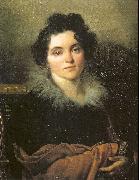 |
Kiprensky, Orest
|
|
Russian Painter, 1782-1836
Russian painter and draughtsman. The leading Russian portrait painter of the Romantic period, he was the illegitimate son of the landowner A. D'yakonov and was adopted by his serf, Adam Shval'b and granted his freedom at birth. His surname is unconnected with that of either his real or his adoptive father, and its origin is uncertain. In 1798 he was sent to the St Petersburg Academy of Arts, eventually studying history painting under Gabriel-Francois Doyen and Grigory Ugryumov. In 1805 he received an important gold medal for his painting Dmitry Donskoy on the Field of Kulikovo (St Petersburg, Rus. Mus.) and won the right to travel to Italy on a scholarship. He did not, however, do so immediately, because of the tense political situation in Europe. Kiprensky's history painting was in keeping with the patriotic mood of Russian society during the years of the war against Napoleon.
|
|
|
|
 |
king Charles Bird
|
|
American portrait Painter, 1785-1862
American painter. He was encouraged to paint by his grandfather, Nathaniel Bird (d 1796), an amateur painter, and took lessons with Samuel King, a portrait painter. In 1800-05 he was apprenticed in New York to Edward Savage, whose curious studio-museum and period of study abroad with Benjamin West impressed him deeply.
|
|
 |
kilian zoll
|
|
Kilian Christoffer Zoll (29 september 1818 - 9 november 1860) was a Swedish artist. He belonged to the Dusseldorf school of painting and painted genre pictures, landscape, portraits, children and altarpieces.
Zoll studied at the Royal Swedish Academy of Arts in Stockholm 1835-1839. Within the Academy, Zoll and his fellow students mostly treated mythical and historical subjects, but as soon as he became independent he devoted himself to genre painting.
He travelled and made sketches through Sweden; Skåne, Halland, Småland and Dalarna. He participated in the academy exhibitions 1850, 1853, 1856 and 1858 with a total of 19 oil paintings. His paintings from this period address topics such as Children playing with a cat, Grandma's joy, Old Woman at the Spinning Wheel.
In 1854 he traveled to Dusseldorf in the company of a fellow artist Bengt Nordenberg. In Dusseldorf he studied art together with another Swedish artist Marcus Larson - together they executed several paintings. He returned to Sweden in 1855. He and Nordenberg tried to get a travel grant from the Swedish Academy of Arts, but he could not get it because he was older than the rules allowed.
The following year he went back to Dusseldorf, now married, and returned to Sweden 1858. Once again, he traveled through the province of Halland in artistic studies and had planned to return to Dusseldorf. He, however, fell ill and died before then.
|
|
 |
KEYSER, Thomas de
|
|
Dutch Baroque Era Painter, ca.1596-1667
son of Hendrick de Keyser I. Following an apprenticeship with an unidentified master in painting, he trained from 1616 to 1618 with his father in architecture. Although he ultimately followed his father and two brothers, Pieter and Willem, into service for the city of Amsterdam as city mason (1662-7), no designs for buildings by Thomas are known, with the exception of an unbuilt triumphal arch published in Salomon de Bray's Architectura moderna
|
|
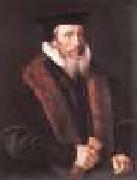 |
KEY, Adriaan
|
|
Flemish painter (b. ca. 1544, Antwerpen, d. after 1589, Antwerpen).
|
|
 |
KEUNINCK, Kerstiaen
|
|
Flemish painter (b. 1560, Kortrijk, d. 1632/3, Antwerpen)
Flemish painter. Although from Courtrai, from an early age he lived in Antwerp. He was listed in 1577 as one of the recipients of the Poor-box (armenbus) of the Antwerp Guild of St Luke, where he was received as master in 1580. He married in 1585. De Keuninck took on Carel de Ferrara as an apprentice in 1599. His son Kerstiaen de Keuninck the younger (d 1642-3) became a master in 1613.
|
|
 |
KETEL, Cornelis
|
|
Dutch painter (b. 1548, Gouda, d. 1616, Amsterdam).
Dutch painter, draughtsman and sculptor, active also in France and England. He was one of the most important portrait and narrative painters of the Dutch Mannerist school of the late 16th century and the early 17th. He received his earliest training in Gouda from his uncle Cornelis Jacobsz. Ketel (d c. 1568) and studied for a year with the painter Anthonie Blocklandt in Delft c. 1565. Ketel then travelled to France and lived in Paris and Fontainebleau.
|
|
|
|
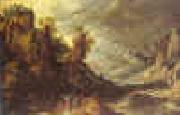 |
Kerstiaen de Keuninck
|
|
1560-1635
Flemish
Kerstiaen de Keuninck Gallery
Flemish painter. Although from Courtrai, from an early age he lived in Antwerp. He was listed in 1577 as one of the recipients of the Poor-box (armenbus) of the Antwerp Guild of St Luke, where he was received as master in 1580. He married in 1585. De Keuninck took on Carel de Ferrara as an apprentice in 1599. His son Kerstiaen de Keuninck the younger (d 1642-3) became a master in 1613. In 1629 Engel Ergo started an apprenticeship with a Kerstiaen de Keuninck: it is not clear whether this refers to father or son.
|
|
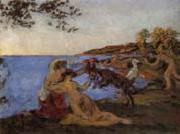 |
Ker xavier roussel
|
|
French Nabi Painter, 1867-1944
was a French painter associated with Les Nabis. Born François Xavier Roussel in Lorry-les-Metz, Moselle, at age fifteen he studied at the Lycee Condorcet in Paris; alongside his friend Édouard Vuillard, he also studied at the studio of painter Diogene Maillart. In 1888 he enrolled in the École des Beaux-Arts, and soon began frequenting the Academie Julian where Maurice Denis and other students formed the group Les Nabis. He is best known for paintings of French landscapes usually depicting women, children, nymphs and fauns in bucolic settings. In 1899, Roussel, Vuillard, and another close friend, Pierre Bonnard, traveled to Lake Como, Venice and Milan. In 1926 Ker-Xavier Roussel won the Carnegie Prize for art. Ker-Xavier Roussel died in 1944 at his home in L'Étang-la-Ville, Yvelines. Roussel is mentioned in Gertrude Stein's Autobiography of Alice B. Toklas, chapter 3. There she recounts an exchange he had with Theodore Duret in Vollard's shop at an uncertain date after 1904.
|
|
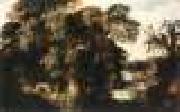 |
KEIRINCKX, Alexander
|
|
Flemish painter (b. 1600, Antwerpen, d. 1652, Amsterdam).
Flemish painter. He was the son of Matthijs Keirinckx and Anna Masson. In 1619 he became a master in Antwerp's Guild of St Luke, he married Clara Matthausen on 18 June 1622, and in 1624 he took on Artus Verhoeven as an apprentice. From 1636 onwards he is regularly recorded in Amsterdam, where he was registered as a citizen in the year of his death. He visited Great Britain, possibly in 1625 (Walpole mentions two signed and dated drawings of London views from this year) and definitely in 1640-41, when he undertook commissions from King Charles I to paint views of royal castles and palaces.
|
|
|
|
|
|
|
|
|
| Wholesale China Oil Painting Wholesale Oil Painting China Xiamen Portrait Reproduction on canvas Chinese Oil Painting Wholesale USA Oil Painting |
|
|
|
|
|